By Jeff W. Zimba
The Black Rifle community is as diverse as the number of optional available weapon configurations: and that number is quickly heading towards infinite. Opinions run deep on topics such as effective barrel lengths, gas systems, accessories and even calibers. While most just boil down to personal preference with few real “wrong answers,” those who harbor these opinions are passionate and serious. One thing that most people who are hard-core, life-long fans of the AR-15/M16/M4 weapons system DO have in common is a zeal for early designs and obscure configurations. The early belt-fed black rifle designs may indeed be the Holy Grail of this system and Small Arms Review is pleased to have obtained an original Colt/Ciener AR-15 H-Bar to examine.

In the Beginning
In the late 1950s, Eugene Stoner and his engineers at ArmaLite had the idea to try a belt-feed unit chambered in .308 on one of his AR-10 designs. While the system indeed worked, and the U.S was actively searching for a new system of this sort, the idea was never actually brought to production. The Dutch AR-10 programs experimented further with the belt-fed AR-10. A little later, the Colt Firearms experimental group toyed with the idea of scaling the system down for 5.56x45mm to be hosted on one of the early AR-15 platforms. Under the supervision of Rob Roy, they produced less than a dozen prototype guns, all slightly different, but the project was eventually abandoned for over 20 years while designs went in the direction of the standard magazine-fed guns we are all familiar with today, which has ended up as the primary weapon system for the United States military for several decades. There is a lot of speculation, and many theories, why the belt-fed AR-15 never took off in those early days and most revolve around the deep interest in “upgrading” to the more potent and powerful 7.62×51 NATO cartridge.
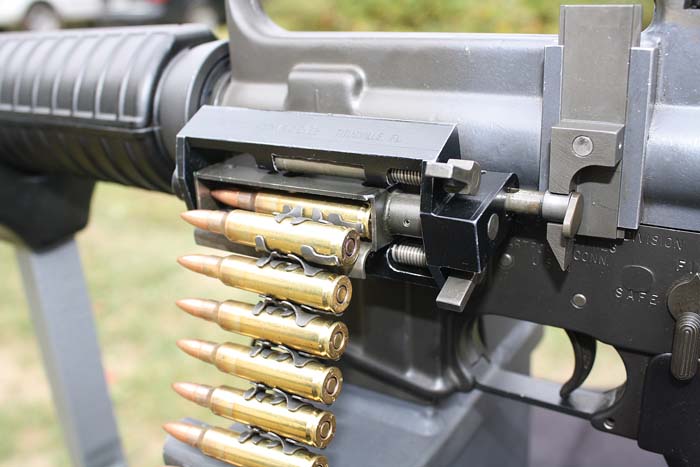
Fast Forward to the Mid 1980s
Jonathan Arthur Ciener had been manufacturing machine guns and sound suppressors since the mid-1970s, and his products have become a staple in the Class III industry. Best known at the time for his silencers, he was producing quality (and very effective) suppressors with an interest in the civilian market; an area that received little attention at the time. While many other legendary manufacturers in our community were engaged in the military weapons market at the same time, most were working in the direction of the sacred U.S. Government contract and the recreational and civilian shooters remained a very small percentage of the overall manufacturing and marketing plans of the era.
While not all alone, Jonathan Ciener was standing tall in his efforts of actively designing, manufacturing and marketing silencers and machine guns for the civilian market. Few of us who were an active part of the “Gun Culture” during the early 1980s will forget the red and white, multi-page catalogs published by Ciener, as they were an important piece of reference literature and used to introduce thousands of civilian shooters to the availability of these firearms. While the pages were filled with many of Ciener’s offerings in the suppressor arena, there were also pages of his machine guns, grenade launchers and related accessories. They explained the legalities of owning these firearms and devices and included retail pricing for those interested in purchasing them. Many were indeed considered “wish-books” and collected like fine literature. In the late 1980s (or perhaps early 1990s) there was a 2-page spread added to the latest catalog, which included and detailed the newly available Belt-Fed AR-15. Ciener’s first product offerings were “kits” to make your own Belt-Fed AR-15, but eventually he offered the complete service.
For the first time in the civilian market a currently produced belt-fed semiautomatic firearm was offered for sale, and the platform was the tried and true AR-15. This was also the first time a belt-fed firearm was offered to the public in the United States, chambered in .223 (5.56x45mm).
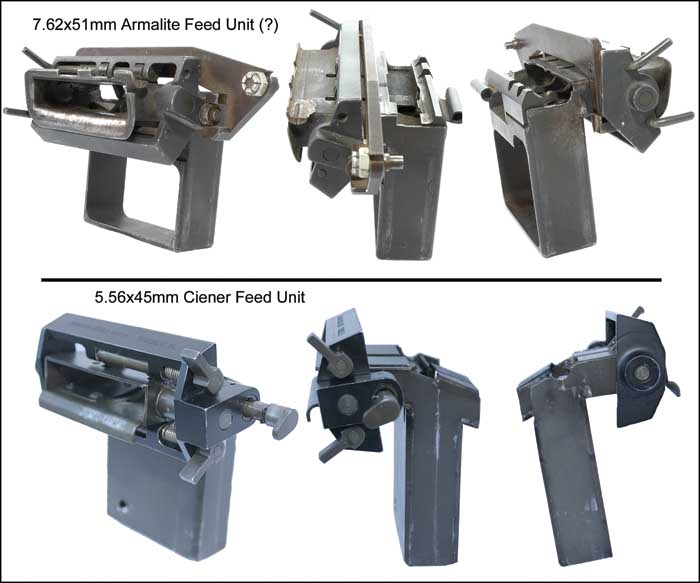
Same Thing, Just Different
With several differences from other available belt-fed firearms, the most unique feature may have actually been the lack of a top cover and additional top mounted feed mechanism such as that used by almost every other system of the time. Immediately recognizable from previous belt-fed designs including Maxim and Browning machine guns, the German MG34 and MG42 guns, the M60 and even the M249 SAW and M240 GPMG, there is no top cover, and like on a few of them, no roller assisted track feed mechanism above the action of the Ciener Belt-Fed AR-15.
The actual feeding and firing function of the Ciener gun very closely mimics the original black rifle, stripping the rounds from the belt in the same manor as stripping the rounds from a standard bottom loaded box magazine and fired from the same closed bolt. The mechanism works so close to the original design that without the use of any tools the belt-feed mechanism can be removed and the gun would still function perfectly when fed from a normal box magazine, regardless of the capacity. With the Ciener conversion, the gun is completely backwards compatible to allow the use of both standard box magazines and the new belt-feed system.
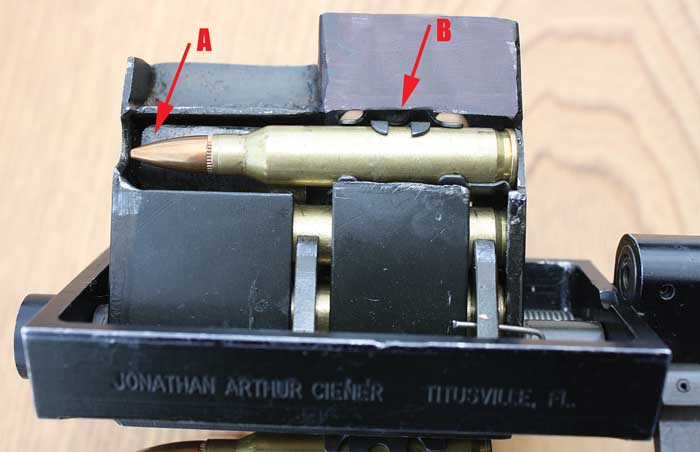
How DOES it Work?
Since there is no top cover and no standard shuttle feed mechanism, the gun needs to harness the energy from somewhere else. Like many others, the rearward motion of the bolt carrier is still harnessed to provide the energy to pull the belt into the action but it is captured on the side of the bolt instead of the top. There is an angled slot milled into the left side of the bolt carrier which captures a steel pin that travels through the outside of the upper receiver to the exterior drive unit. When the belt-feed mechanism is installed, (simply inserted into the magazine-well of an open lower receiver) it connects to this sliding drive unit with a spring-loaded pawl lock for easy installation and removal.
Looking inside the feed mechanism when it is installed will reveal four spring loaded feed pawls. There are two on the top and two on the bottom. These pawls cam up and down as the mechanism rocks (in a see-saw motion) caused from the exterior drive lifting and lowering the linkage as the bolt carrier moved from front to rear and back again. These pawls pull, than hold the belted ammo in the mechanism in sequence as it rocks back and forth. Just like the unmodified rifle, it fires from a closed bolt so a round may be loaded and ready to fire in situations where such a condition is desired and determined safe.

Upon further examination of the feed mechanism, a small piece of spring steel can be seen to the front of the feed pawls. This creates a light but steady amount of lift necessary for proper round presentation for reliable feeding. As mentioned previously, the round is presented to the bolt carrier and bolt just as if it is being fed from an inserted magazine.
As the round is stripped from the link and chambered, the belt advances from the motion caused by the cam slot on the forward moving bolt carrier and the empty link advances out and into the link chute or onto the ground. Since the links are modified XM27 (M249/Minimi) links and VERY expensive to purchase as modified, it is suggested to use the link chute.
The link modification is a precise slot that exposes almost 1/2 the diameter of the round. Looking inside the mechanism for a short time, this “head scratcher” of a modification turns into an incredibly logical and necessary step. Since the belt is fed from the side and presented for feeding from the bottom (like a standard magazine) it is missing the stability and support of the feed lips of an actual magazine that holds the round perfectly in line with the chamber as it is stripped by the bolt. Since it is only supported on the side by the link and held up on the front it has a tendency to twist to the left as it is being pushed from the link. This would cause an immediate feeding problem due to the unsupported alignment. Colt solved this issue by adding a small tooth to the link chute, which acts as a “feeding boss” holding the link from the right when the slot from the previous link slides over the tooth. This gives the round a strait and stable platform to sit in while being chambered. This “boss” tooth is part of the drop-in feed mechanism and not the collection chute so for those less concerned with collecting these links it is possible to use it without the box.
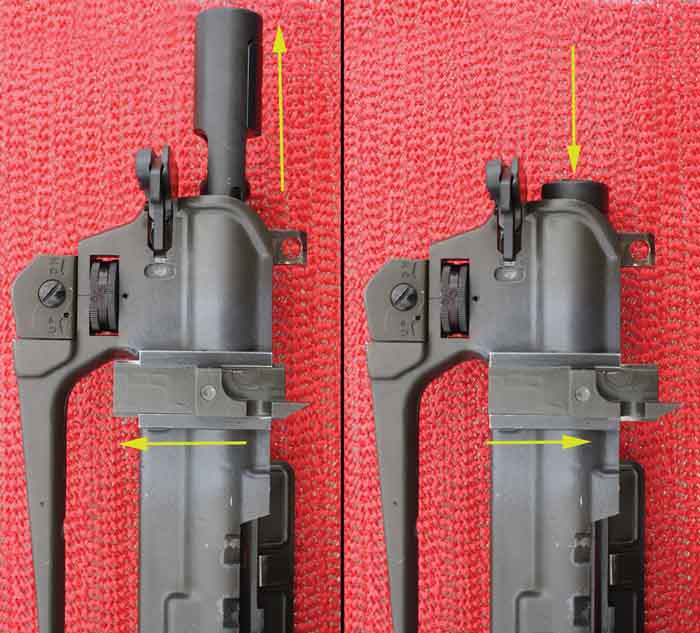
Ciener’s AR-15 Modifications
When the Ciener belt-fed AR-15 and M16 was introduced, purchasers had the option of purchasing one off the shelf or sending their original Colt rifle in for the necessary modifications. The work is extensive to the original gun and it is far from a drop-in conversion. As previously mentioned though, once the conversion is completed the belt-feed mechanism can easily be removed to use the rifle with standard magazines.
The upper receiver is modified by removing material to allow the feed mechanism to fit in the gun and the exterior drive unit is installed. The bolt carrier is slotted to intercept the steel cam pin, which connects to the linkage in the belt-feed unit once installed in the lower receiver. The lower receiver is also modified by removing material to accept the belt-feed mechanism. The rifle will function normally with a standard magazine but these receiver modifications will act as “windows” allowing the user to see a portion of the magazine when using it in this manor. Even after it is modified a standard upper receiver may be used with the lower receiver functioning like a factory gun was intended. If the Ciener upper is to be used with a standard box magazine, the modified bolt carrier must still be used due to the addition of the steel cam pin.
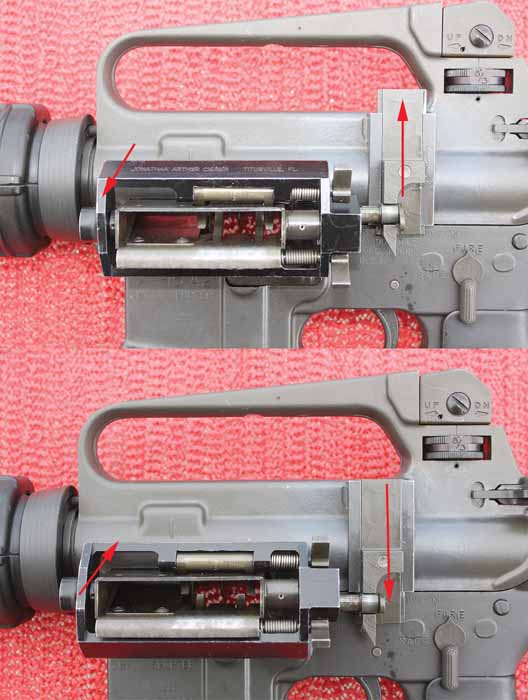
Inserting and removing the belt-feed mechanism is as simple as opening the rifle in the normal fashion. The rear takedown pin is pushed through and the upper is opened by rotating on the front takedown pin. The belt-feed mechanism is dropped into the mag-well and automatically lined up for closing. As the upper is closed onto the lower, the spring-loaded pawl lock is depressed and allowed to spring back into the exterior drive unit on the upper receiver. To remove the mechanism, it is done in reverse order starting with depressing the spring-loaded pawl lock.
The bottom of the belt-feed mechanism extends past the bottom of the mag-well to act as the attachment point for the belt feed box and link chute. The box has a separate compartment to hold the fired links so they do not mix with the belted ammunition. The box can be removed by one of two methods. It is secured to the bottom of the feed mechanism with a single pushpin. It can either be removed completely by pulling and removing the pin or a toggle switch can be rotated on the right side of the box allowing just the bottom to slide off to the left for emptying and refilling leaving the link chute attached to the gun. The latter is much easier when a simple reload is in order.
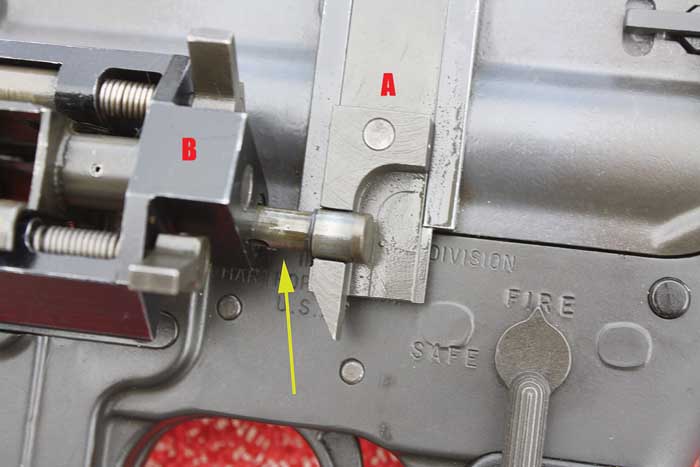
Live Fire
The first order is to link the ammo and fill the feed box. Ammo is pressed into the links until it snaps into place. At the end of the belt should be an end tab which consists of two dummy rounds and a 2.25-inch tab. The end tab allows the bolt to be held open upon firing the last round, which would not happen since there is no “follower” as in a conventional box magazine.
Unlike many other belt-fed firearms, the ammo is loaded with the links down instead of the normal “brass to grass” protocol. This is so the links are on the bottom and the rounds are pushed over them just like being pushed up and out of a box magazine.
To insert the belt, the bolt carrier needs to be locked back. This is a BIG issue of concern because if the entire system has any flaws at all, this is it. Reading close here can save the user a lot of embarrassment and a fair amount of pain. The bolt release is concealed behind the belt-feed mechanism when it is installed and caution must be used anytime this is engaged. NEVER, at anytime, should the user hit the bolt release with anything considered essential equipment (like fingers or a thumb) when the bolt is back! (Yes, this writer knows this from first-hand stupidity, er… ah… I mean experience).
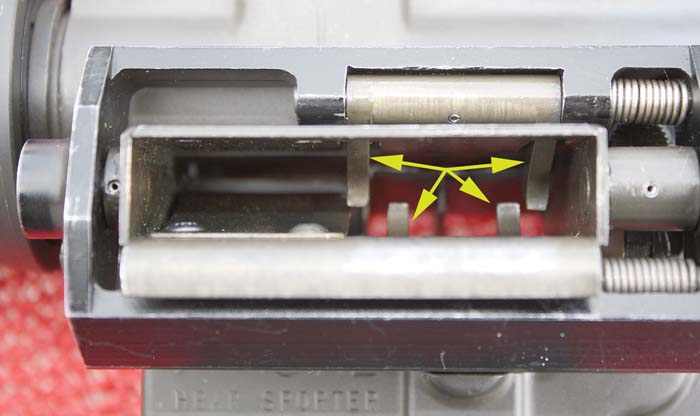
With the bolt back we inserted the belt (links down) until it clicked twice. A view inside the dust cover revealed the round properly seated for feeding with the groove in the link engaged in the tooth portion of the link chute. With a small tug on the charging handle the bolt was slammed home and in battery.
The day was started with a quantity of Federal XM193 ammo, all of which ran without so much as a glitch. After a small rear sight adjustment we shot 10-round groups for hours switching between 3 shooters. Factory A2 sights were all we used and the distance was approximately 60 yards. Since the purpose of the testing was for function, we were satisfied with the distance and sight combination as multiple 2-inch and 3-inch groups were repeated throughout the afternoon. After we exhausted the Federal ammo we linked a fair quantity of Wolf Polyformance ammunition and repeated the process. The groups were the same and the only malfunction we encountered was a failure to feed with what turned out to be a bent link.
It will be interesting in the future to mount some optics and shoot for accuracy at a proper distance but it wasn’t on the agenda for this test. What was noticed was the consistency of the ejected casings. We were running 50-round belts all from the box, and one shooter commented that we could have placed a coffee can 3 feet from the bench in a 4 o’clock position and have caught about 98% of the empty casings. Amazingly enough they all looked as though they were being “policed” throughout the day just because of the pile they were in getting higher and higher.
After each belt would empty, the bolt carrier would CAREFULLY be locked back, and the ears releasing the pawls were depressed to remove the end tab and dummy rounds. This would leave it ready for the next reload.
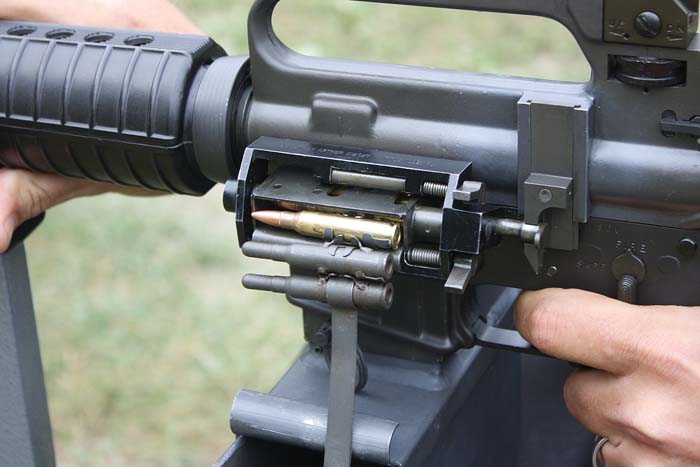
Conclusion
Without a doubt, this is a gun that should still be in production. We have no idea if it would be price prohibitive to manufacture or what the market would be, but we know that everyone who has handled this has been extremely impressed and envious. The quality of this gun is nothing short of amazing and it is obvious the first time the charging handle is pulled back and the glass-smooth action is felt. The parts are true poetry in motion for something so radically different from the original design.
Having an excellent running example that was spawned from such an important era in the wonder years of “modern” firearms designs is almost priceless. When handling this gun it is impossible not to think of “what could have been” during these sensitive trials and test periods that gave us the designs we have today.
This is the place we would usually list the manufacturer’s information and suggested retail pricing, but since these guns have long been unavailable, we won’t irritate Mr. Ciener by adding his current contact information here. He has been out of the belt-fed AR business for a long time and specializes today in .22 LR subcaliber units for several modern firearms. We have heard though that he may have just a few of these left in inventory from years ago, and if you do happen to run into him it may be worth asking if they are for sale.

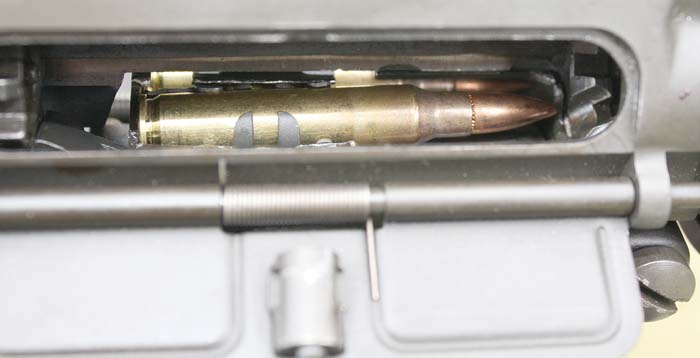
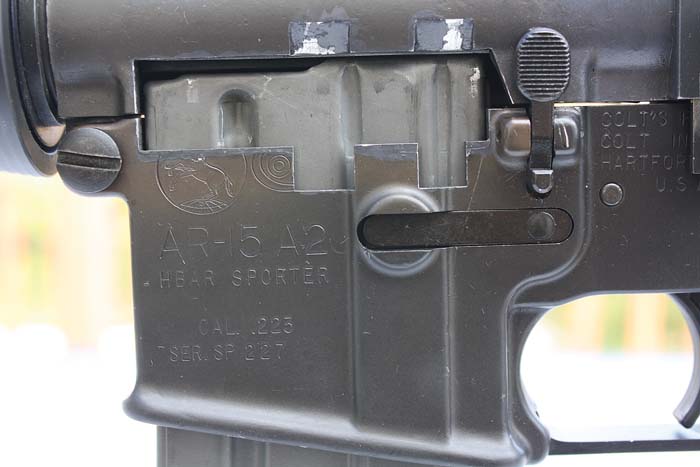
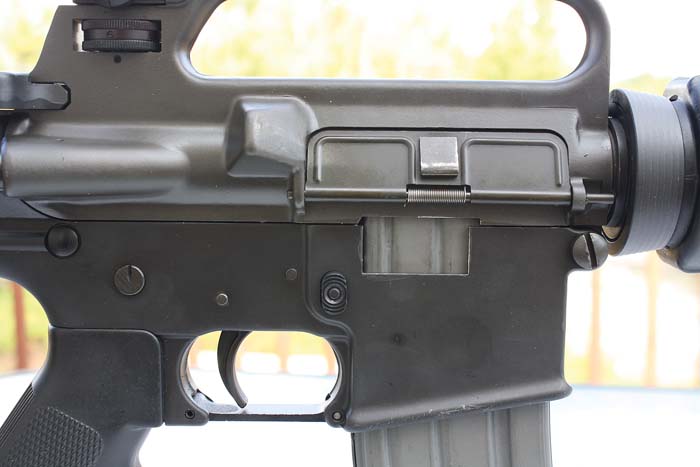
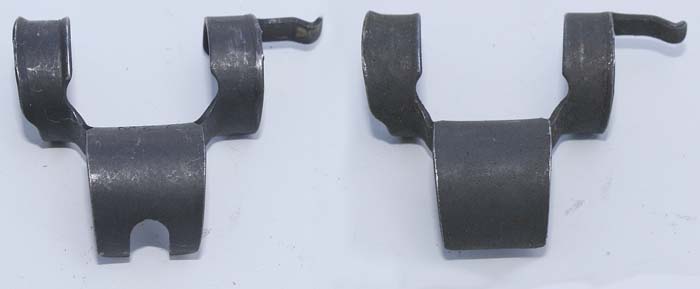
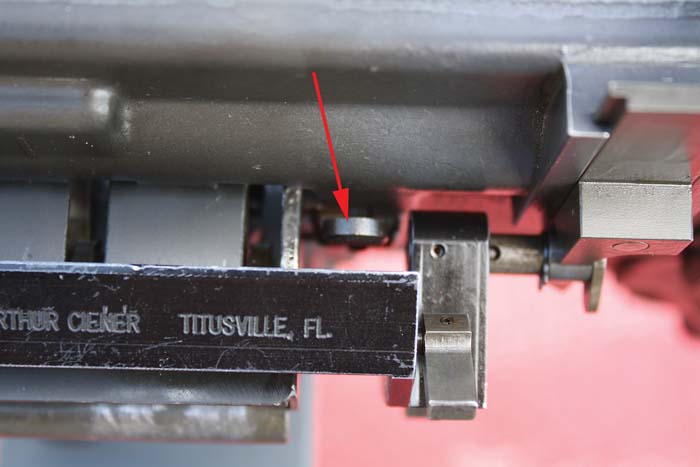
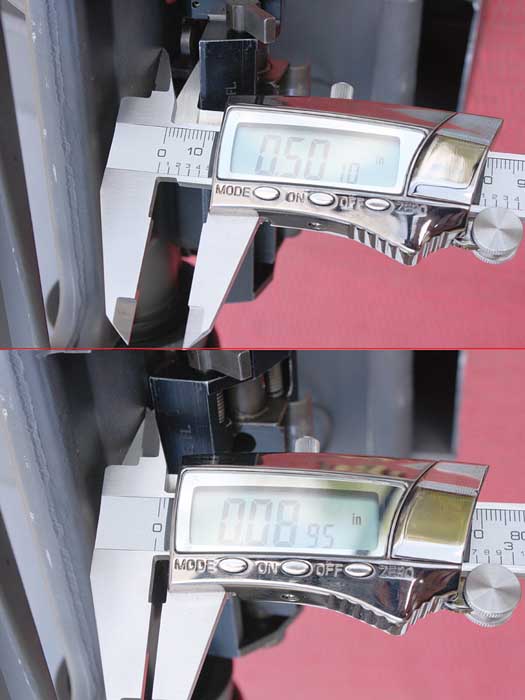
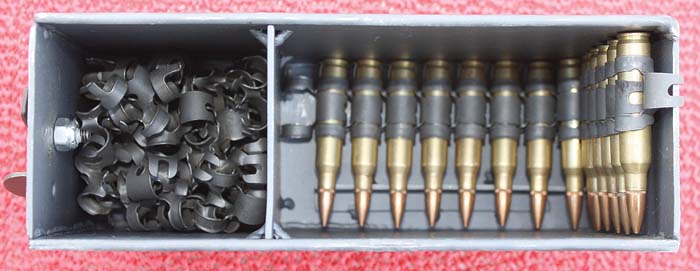
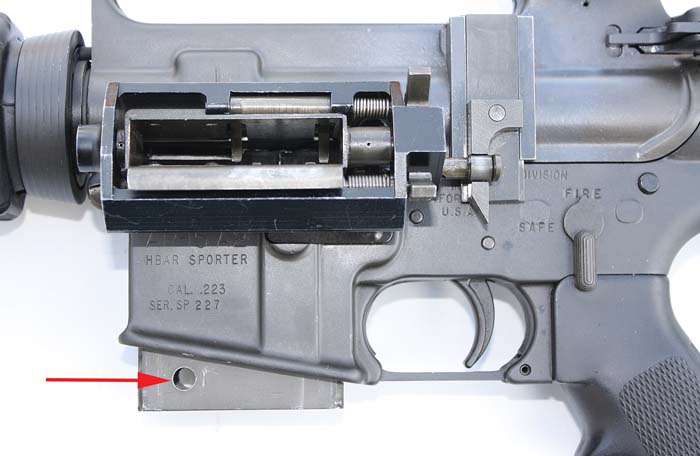
| This article first appeared in Small Arms Review V13N4 (January 2010) |











